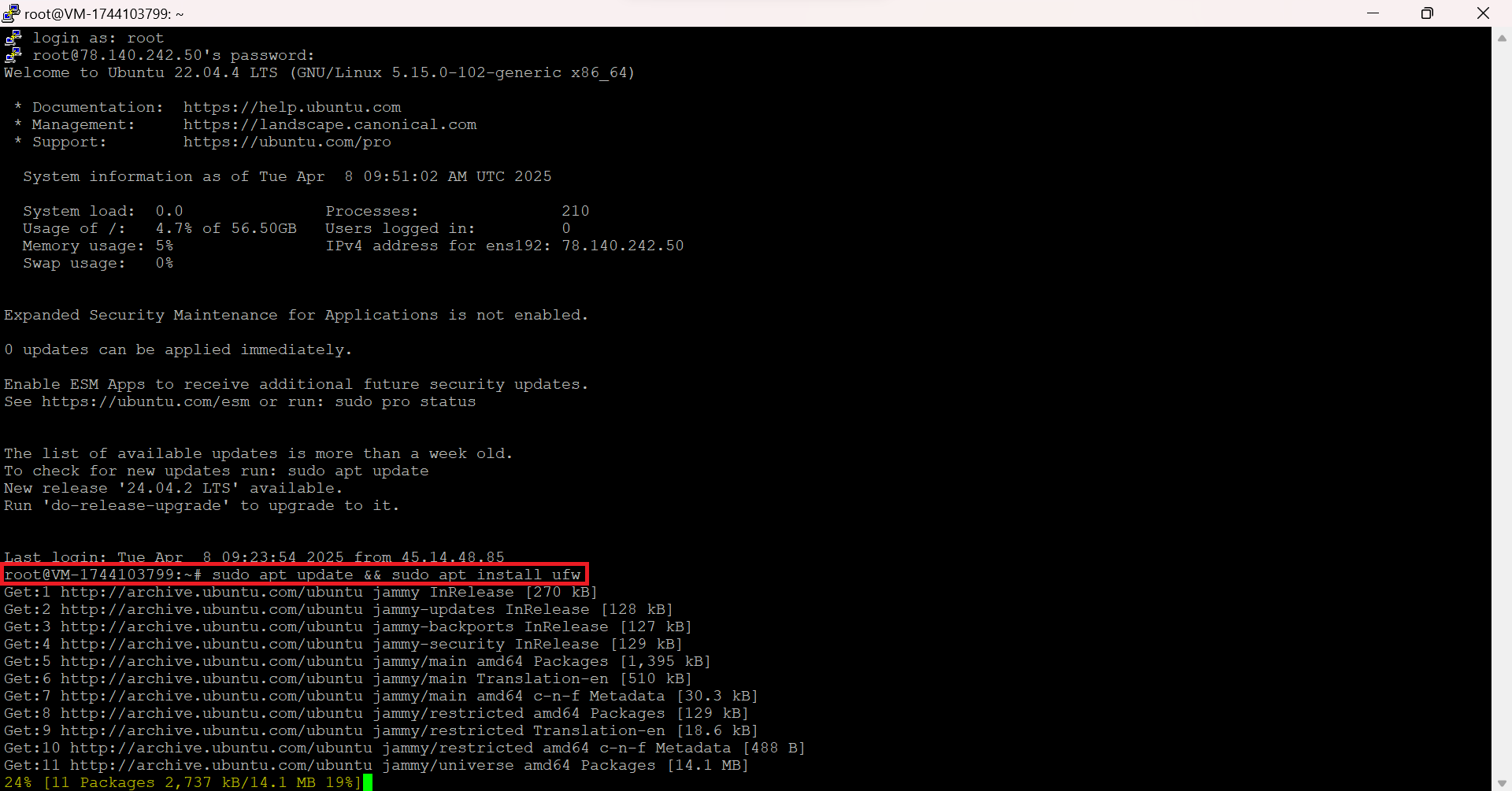Introduction
Ubuntu uses UFW (Uncomplicated Firewall) as the default tool for configuring the firewall. It simplifies the use of iptables, allowing for quick and easy setup of server protection using both IPv4 and IPv6. By default, UFW is disabled, but you can easily install it:
sudo apt update && sudo apt install ufw 
Checking UFW Status
To check whether the firewall is active:
sudo ufw status If you see Status: inactive, it means the firewall is currently disabled.

Enabling UFW
Warning! If you're connected via SSH, allow SSH access before enabling UFW, or you might get locked out.
To enable UFW:
sudo ufw enable 
To see the list of current rules:
sudo ufw status verbose 
Disabling UFW
To temporarily disable the firewall:
sudo ufw disable Note: This completely turns off your firewall—use with caution!

Blocking IP Addresses and Subnets
- Block a specific IP:
sudo ufw deny from 91.198.174.190 - Block an entire subnet:
sudo ufw deny from 91.198.174.0/24 - Block an IP on a specific interface:
sudo ufw deny in on eth0 from 91.198.174.192 Allowing IP Addresses
- Allow all traffic from a specific IP:
sudo ufw allow from 91.198.174.192 - Allow incoming traffic from an IP on a specific interface:
sudo ufw allow in on eth0 from 91.198.174.22 Deleting Rules
- Delete a rule by its parameters:
sudo ufw delete allow from 91.198.174.192 - Delete a rule by number:
sudo ufw status numbered sudo ufw delete 1 Application Profiles
UFW can use predefined profiles for common services:
- List available profiles:
sudo ufw app list - Enable a profile (e.g. OpenSSH):
sudo ufw allow OpenSSH - Remove a profile:
sudo ufw delete allow "Nginx Full" 
Opening Common Ports
- SSH (port 22):
sudo ufw allow 22 - HTTP (port 80):
sudo ufw allow http - HTTPS (port 443):
sudo ufw allow https - HTTP + HTTPS combined:
sudo ufw allow proto tcp from any to any port 80,443 Allowing Database Connections
- MySQL (port 3306):
sudo ufw allow from 91.198.174.33 to any port 3306 - PostgreSQL (port 5432):
sudo ufw allow from 91.198.174.33 to any port 5432 - Allow for a subnet:
sudo ufw allow from 91.198.174.0/24 to any port 3306 FAQ: UFW (Uncomplicated Firewall) on Ubuntu
- Q1: How can I check which UFW rules are currently applied?
A1: Run the command:sudo ufw status verboseThis shows all active rules, including allowed ports and IP addresses.
- Q2: What if I accidentally block SSH access?
A2: Use your hosting provider’s console or IPMI/KVM access, then run:sudo ufw allow OpenSSHThis restores SSH connectivity safely.
- Q3: Can I allow multiple ports at once?
A3: Yes. For example, to allow HTTP and HTTPS together:sudo ufw allow proto tcp from any to any port 80,443You can adjust the ports as needed for your services.
- Q4: How do I remove a UFW rule I added by mistake?
A4: First, list rules with numbers:sudo ufw status numberedThen delete the unwanted rule by its number:
sudo ufw delete <rule_number> - Q5: What should I do if UFW conflicts with another firewall?
A5: Disable the other firewall (e.g., firewalld) or ensure it’s not managing the same ports and rules to avoid conflicts. - Q6: Can UFW manage both IPv4 and IPv6 traffic?
A6: Yes. UFW handles IPv4 and IPv6 simultaneously if configured in /etc/default/ufw by setting IPV6=yes.
Conclusion
Configuring UFW on Ubuntu provides a straightforward and effective way to secure your server by controlling network traffic. By simplifying the complex iptables rules, UFW makes it easier for users to implement firewall policies without requiring deep networking knowledge.
UFW is particularly useful for small to medium-sized environments, where ease of use and flexibility are essential. When setting up UFW, it’s important to prioritize securing critical services such as SSH, HTTP, and database connections, while avoiding accidental blocking of necessary traffic.
Regularly reviewing and updating firewall rules is key to maintaining ongoing security. Leveraging application profiles for common services can further streamline the configuration process and reduce the risk of misconfigurations.
Ultimately, using UFW effectively can greatly enhance the security of your Ubuntu server while keeping the setup process manageable, efficient, and reliable.




